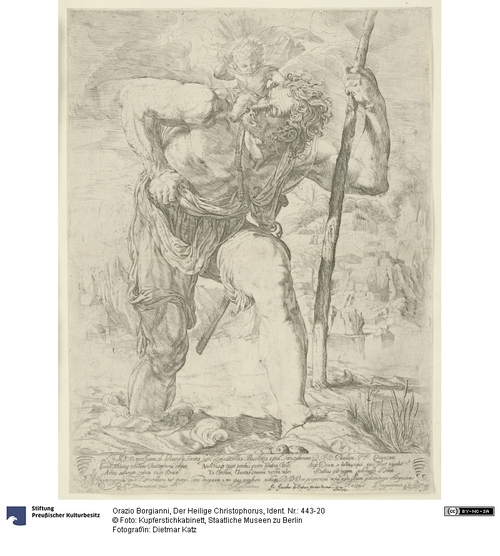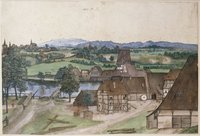Der Heilige Christophorus gilt als Schutzpatron der Reisenden, sein Segen soll unterwegs vor Unfall und Gefahr schützen. Die riesige, kraftstrotzende Gestalt des Heiligen nimmt das gesamte Blatt ein. Der Legende nach trug er ein kleines Kind über einen Fluss, das unerklärlicherweise immer schwerer zu werden schien. Hier ist der Moment dargestellt, in dem er, auf seinen Stock gestützt, mit letzter Kraft das Ufer erreicht. Dort gibt sich das Kind als Christuskind zu erkennen – hier charakterisiert durch einen strahlenden Nimbus. Es offenbart dem Christophorus (griechisch: „Christusträger“), dass er mit ihm die gesamte Last der Welt auf seinen Schultern getragen habe. Dieses Blatt gibt besonders eindrucksvoll den Gegensatz zwischen dem muskulösen Mann und dem zarten Kind wieder, einen Kontrast, der noch unterstrichen wird durch die Verwendung von dunkleren, tiefen beziehungsweise sanften, helleren Linien. Der Römer Orazio Borgianni widmet diese Radierung in der ausführlichen Inschrift seinem Freund Juan de Lezcano, damals Sekretär des Spanischen Botschafters in Rom. Sie gibt eines von mehreren Gemälden des Künstlers mit diesem Bildmotiv wieder, das er ebenfalls für Lezcano gemalt hatte.
Text: Dagmar Korbacher, in: Wir suchen das Weite. Reisebilder von Albrecht Dürer bis Olafur Eliasson im Kupferstichkabinett, hg. von Hein-Th. Schulze Altcappenberg und Ina Dinter, Berlin 2016, S. 32
St. Christopher is considered the patron saint of travelers: his blessing is supposed to protect those underway from accidents and danger. The huge, powerful figure of the saint fills up the entire sheet. According to legend, St. Christopher carried a small child across a river, who inexplicably became heavier and heavier along the way. This image shows the moment when he reaches the shore, supported by his walking stick, exhausting all his energy: the child now reveals himself to be the Christ Child, characterized here by a glowing halo. He reveals to Christophorus (Greek for “Bearer of Christ”) that he had just borne the entire weight of the world on his shoulders. This etching impressively shows the contrast between the muscular man and the tender child: a contrast that is underscored by the use of darker, deeper lines for Christopher, and gentle, lighter lines for the child. In the extensive inscription, the Roman artist Orazio Borgianni dedicated this etching to his friend Juan de Lezcano, who at the time was secretary to the Spanish Ambassador to Rome. It reflects one of several paintings by the artist with this motif, also painted for Lezcano.
Text: Dagmar Korbacher, in: We’re off then. Travel Pictures from Albrecht Dürer to Olafur Eliasson in the Kupferstichkabinett, published by Hein-Th. Schulze Altcappenberg and Ina Dinter, Berlin 2016, p. 32
Entstehungsort stilistisch: Rom
en

